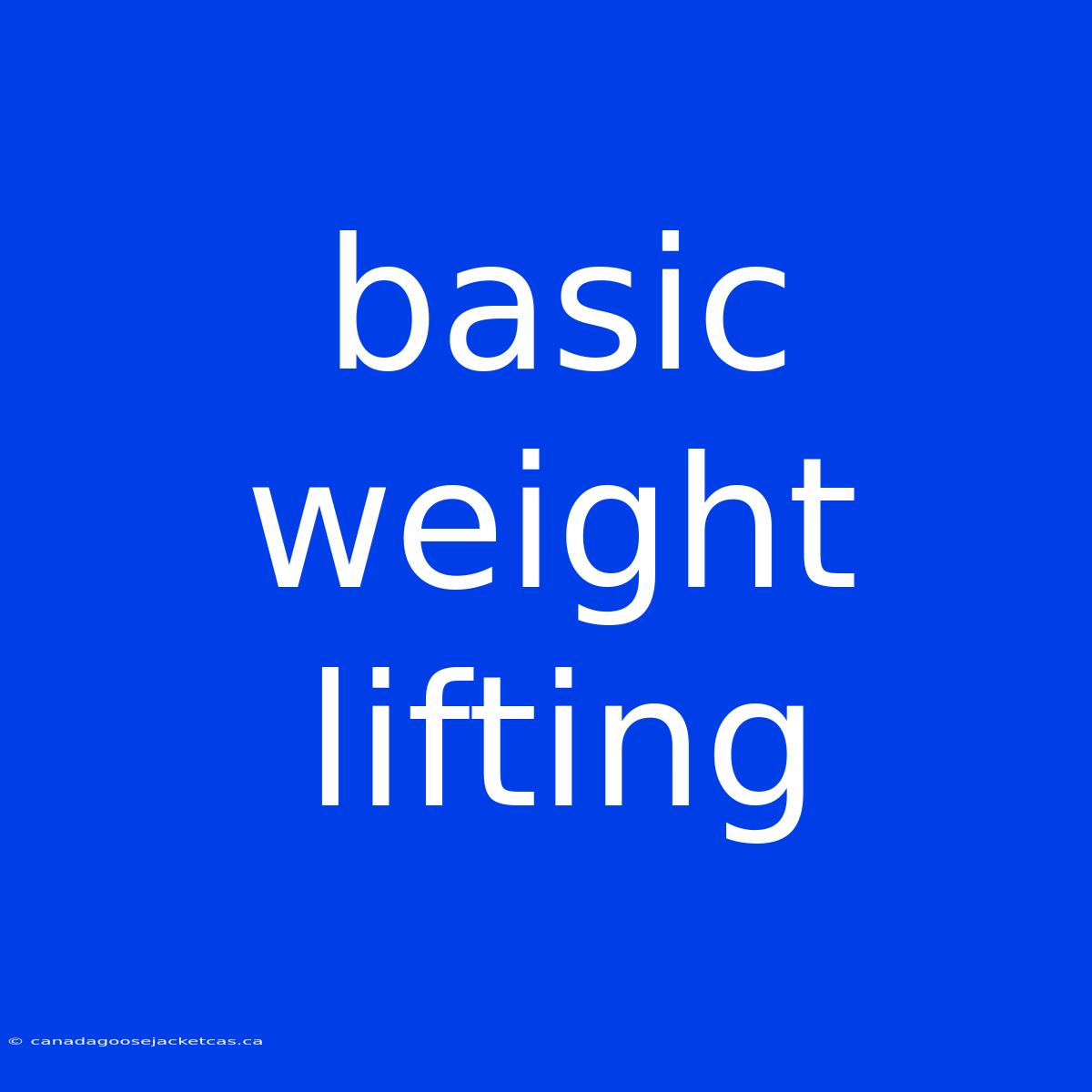Basic Weight Lifting: Your Guide to Building Strength and Muscle
Is weight lifting just for bodybuilders? Absolutely not! Weight lifting offers a wealth of benefits for everyone, regardless of fitness level or goals. From boosting metabolism and improving bone density to enhancing mood and increasing strength, basic weight lifting can transform your overall health and well-being.
Editor Note: This guide provides a comprehensive introduction to basic weight lifting, covering the essential principles and techniques for beginners.
Why is basic weight lifting important?
- Strength building: Weight training strengthens muscles, making everyday activities easier and preventing injuries.
- Muscle growth: Weight lifting stimulates muscle protein synthesis, leading to increased muscle mass.
- Improved metabolism: Muscle tissue burns more calories at rest, boosting metabolism and aiding weight management.
- Enhanced bone density: Resistance training helps build stronger bones, reducing the risk of osteoporosis.
- Improved cardiovascular health: Weight lifting can improve heart health by increasing blood flow and lowering resting heart rate.
Our Analysis: We've meticulously analyzed the best resources and gathered practical insights from experienced fitness professionals to craft this user-friendly guide for beginners.
Key takeaways from this guide:
| Takeaway | Explanation |
|---|---|
| Understanding compound movements | Compound exercises target multiple muscle groups simultaneously, maximizing efficiency. |
| Mastering form over weight | Proper form ensures safety and maximizes muscle activation. |
| Progressive overload for muscle growth | Gradually increasing weight or resistance over time challenges muscles and stimulates growth. |
| Prioritizing rest and recovery | Allowing sufficient rest allows muscles to repair and grow stronger. |
| Listening to your body | Pay attention to pain and discomfort, and adjust training accordingly. |
Let's delve into the core aspects of basic weight lifting:
Understanding Compound Movements
Compound movements engage multiple muscle groups simultaneously, making them incredibly efficient for building overall strength and muscle mass. These are the foundation of any basic weight lifting routine:
- Squats: Target quads, hamstrings, glutes, and calves.
- Deadlifts: Work the entire posterior chain (back, glutes, hamstrings).
- Bench press: Focus on chest, triceps, and shoulders.
- Overhead press: Targets shoulders, triceps, and upper back.
- Rows: Strengthen back, biceps, and forearms.
Mastering Form Over Weight
Maintaining proper form is crucial for safety and maximizing muscle activation. Prioritize perfect technique over lifting heavy weights. Focus on:
- Full range of motion: Ensure a complete movement through the exercise's entire range.
- Controlled tempo: Avoid rushing through repetitions, maintaining a steady pace.
- Neutral spine: Maintain a neutral spine throughout the exercise to avoid injury.
Progressive Overload for Muscle Growth
To stimulate muscle growth, gradually increase the weight, repetitions, or sets over time. This challenges your muscles and forces them to adapt, leading to growth.
Prioritizing Rest and Recovery
Rest is essential for muscle growth and recovery. Ensure adequate sleep (7-9 hours) and allow for 1-2 days of rest between workouts.
Listening to Your Body
Pay attention to your body's signals. If you experience pain, stop the exercise and consult with a healthcare professional.
The Importance of Warm-Up and Cool-Down
- Warm-up: Begin each workout with 5-10 minutes of light cardio followed by dynamic stretching to prepare your body for weight lifting.
- Cool-down: End your workout with 5-10 minutes of light cardio and static stretching to help your muscles recover and prevent soreness.
Basic Weight Lifting Routine for Beginners
Day 1: Upper Body
- Bench press: 3 sets of 8-12 repetitions.
- Overhead press: 3 sets of 8-12 repetitions.
- Rows: 3 sets of 8-12 repetitions.
Day 2: Lower Body
- Squats: 3 sets of 8-12 repetitions.
- Deadlifts: 3 sets of 5-8 repetitions.
Day 3: Rest
Day 4: Repeat Day 1
Day 5: Repeat Day 2
Day 6: Rest
Day 7: Active rest (light cardio or stretching)
FAQ: Basic Weight Lifting
Q: How much weight should I lift?
A: Start with a weight that allows you to complete 8-12 repetitions with good form. Gradually increase the weight as you get stronger.
Q: How often should I lift weights?
A: Aim for 2-3 weightlifting sessions per week with at least one rest day between each session.
Q: What if I don't have access to a gym?
A: You can still get an effective workout at home using bodyweight exercises, resistance bands, or dumbbells.
Q: What are some common weightlifting mistakes?
A: Common mistakes include:
- Not using proper form
- Lifting too much weight too soon
- Not warming up or cooling down properly
- Not getting enough rest and recovery
Tips for Effective Basic Weight Lifting
- Focus on form over weight: Prioritize perfect technique over lifting heavy weights.
- Gradually increase the weight: Challenge your muscles progressively to promote growth.
- Use a spotter for heavy lifts: Ensure safety, especially for exercises like squats and deadlifts.
- Listen to your body and rest when needed: Avoid overtraining to prevent injury and promote recovery.
- Stay hydrated and eat a balanced diet: Proper nutrition is essential for muscle growth and recovery.
Summary of Basic Weight Lifting
Basic weight lifting offers a multitude of benefits for individuals of all fitness levels. By understanding compound movements, mastering form, and prioritizing progressive overload, you can achieve your fitness goals safely and effectively. Remember to warm up before each workout, cool down afterward, and listen to your body's signals.
Closing Message
Embarking on your basic weightlifting journey can be incredibly rewarding, leading to increased strength, muscle mass, and overall well-being. Remember, consistency, proper technique, and patience are key to maximizing results and enjoying the benefits of this versatile form of exercise.

